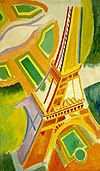
The Eiffel Tower series of Robert Delaunay (1885–1941) is a cycle of paintings and drawings of the Eiffel Tower. The Eiffel Tower was built by Gustave Eiffel.
The series was painted in an emerging Orphist style, an art movement co-founded by Robert and Sonia Delaunay and František Kupka that added bright colors and increased abstraction to Cubism. The Eiffel Tower series sits chronologically and stylistically between the artist's Saint-Séverin series and Windows series.
Eiffel Tower as symbol
| This section is empty. You can help by adding to it. (May 2022) |
Course of style over series
List of works
| Year | Image | Title | Collection |
|---|---|---|---|
| 1909–12, original series | |||
| 1909 | 
|
La Tour à l'univers s'adresse | Philadelphia Museum of Art |
| 1909–10 | 
|
La Tour Eiffel | Staatliche Kunsthalle Karlsruhe |
| 1910 | 
|
La tour aux rideaux | Kunstsammlung Nordrhein-Westfalen |
| 1910 | 
|
Tour Eiffel aux arbres | Solomon R. Guggenheim Museum |
| 1911 | 
|
Tour Eiffel | Solomon R. Guggenheim Museum |
| 1911 | 
|
Champs de Mars: The Red Tower | Art Institute of Chicago |
| 1911–12 | 
|
La Tour Rouge | Solomon R. Guggenheim Museum |
| 1911–12 | 
|
Les trois Grâces (étude pour "La Ville de Paris") | Private collection |
| 1912 | 
|
La Ville de Paris | Musée d'Art Moderne de la Ville de Paris |
| 1920s, return to theme | |||
| 1922 | 
|
La Tour Eiffel et jardin du champs de mars | Hirshhorn Museum and Sculpture Garden |
| 1922 | 
|
La Tour Eiffel | Hirshhorn Museum and Sculpture Garden |
| 1924 | 
|
La Tour Eiffel | Dallas Museum of Art |
| 1926 | 
|
La Tour Eiffel | Musée d'Art Moderne de la Ville de Paris |
| 1926 | 
|
La Tour Eiffel | Musée d'Art Moderne de la Ville de Paris |
| 1926–28 | 
|
La Tour Eiffel | Solomon R. Guggenheim Museum |
Legacy
Delaunay's Eiffel Tower series is evoked in architectural paintings of other iconic buildings by his contemporary, the New York artist John Marin, in his Woolworth Building, No. 31 of 1912, and later by the Ontario artist Greg Curnoe's CN Tower series of the 1970s and 1980s.
The 1913 artist's book La prose du Transsibérien et de la Petite Jehanne de France, a collaborative work between Sonia Delaunay and the poet Blaise Cendrars, forms an epic narrative of a Trans-Siberian Railway journey that concludes in Paris at a Simultanist Eiffel Tower. They had announced a plan to sell 150 copies of the book, which would equal in height the Tower itself.
The Russian film director Sergei Eisenstein's appreciation of Delaunay's work informed his Soviet montage theory, as he imagined developing cinematically "a dynamic fusion of a series, moving past the spectator, of those hundred views of the Eiffel Tower" rather than a "summation within a single canvas".
Cendrars's 1924 essay on Robert Delaunay describes his feminization of the Tower, and Sonia Delaunay described the Eiffel Tower as her husband's "Eve future"
A 1911 painting from the series is featured in the 1980 BBC series 100 Great Paintings.
References
- "Champs de Mars: The Red Tower".
- Panzera, Lisa (2000-01-01). "Italian Futurism and Avant-Garde Painting in the United States". In Berghaus, Günther (ed.). International Futurism in Arts and Literature. Walter de Gruyter. p. 233. ISBN 9783110156812.
- Barrio, Jose L. (1978). "Greg Curnoe: A Proposed Referendum and Five Series". The CCCA Canadian Art Database. artscanada. Archived from the original on 2022-04-12. Retrieved 2015-11-19.
- Affron, Matthew (2012-01-01). "Contrasts of Colors, Contrasts of Words". In Affron, Leah (ed.). Inventing Abstraction, 1910-1925: How a Radical Idea Changed Modern Art. The Museum of Modern Art. p. 83. ISBN 9780870708282.
- Neat, Timothy (2015-10-12). "Invisible Cinema: John Berger, Play Me Something, and Walk Me Home". In Hertel, Ralf; Malcolm, David (eds.). On John Berger: Telling Stories. Brill Rodopi. p. 301. ISBN 9789004308114.
- Gronberg, Tag (2000-01-01). "Deco Venus". In Arscott, Caroline; Scott, Katie (eds.). Manifestations of Venus: Art and Sexuality. Manchester University Press. p. 147. ISBN 9780719055225.
| Robert Delaunay | |
|---|---|
| Paintings |
|
| Painting series |
|
| Related | |